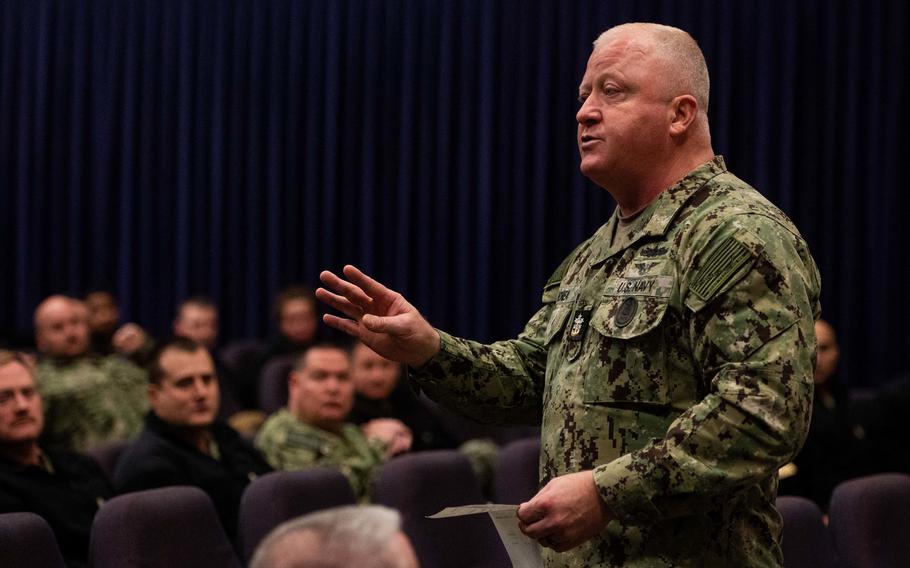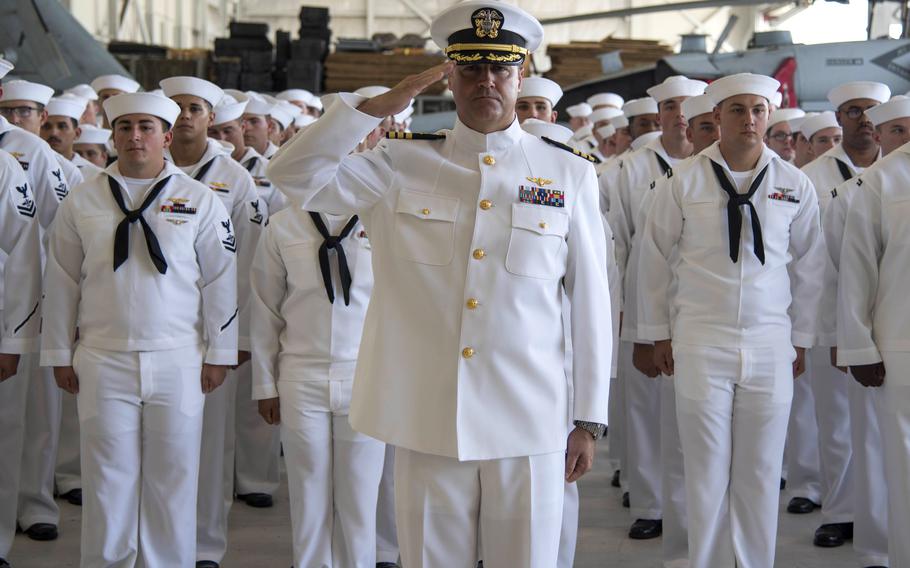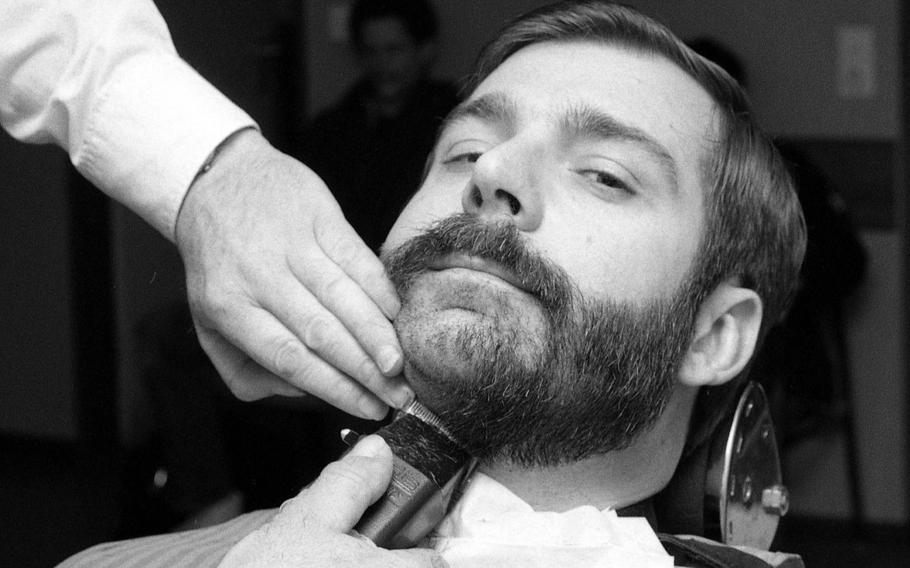
Master Chief Petty Officer of the Navy James Honea speaks with sailors and answers questions during an all-hands call at Naval Air Station Whidbey Island, Wash., in December 2022. Honea has said that beards are “not a hill I want to die on.” (Anna Van Nuys/U.S. Navy)
The Navy is facing a groundswell in its ranks and in court from people who believe that the service needs to take a razor to its 38-year-old beard ban.
“Isn’t it about time?” one retired sailor asked during an open question forum Jan. 19 with the Navy’s top enlisted leader on the social media platform Reddit.
In response to that and related comments, Master Chief Petty Officer of the Navy James Honea said beards are “not a hill I want to die on.”
And a recent court decision asserted that three Sikh Marine Corps recruits likely would win their case challenging requirements that they cut their hair and shave their beards. They had sued on grounds that the grooming rules violate their religious freedom rights.
A panel of the U.S. Court of Appeals for the D.C. Circuit unanimously ruled in December that the Corps hadn’t proved that allowing the recruits to keep their beards and turbans would threaten cohesion and uniformity, The Washington Post reported Dec. 23.
The decision cleared the way for an injunction allowing the men to attend boot camp without shaving their beards or cutting their hair while their lawsuit continues.

Sailors stand at attention during a change of command ceremony in Norfolk, Va., in 2017. For now at least, U.S. Navy sailors generally will remain clean-shaven. (Nathan T. Beard/U.S. Navy)
Instituted in 1985, the Navy’s ban marked a major reversal, given that for much of the service’s history, sailors were allowed to wear beards.
Adm. James Watkins, the chief of naval operations at the time, explained his decision requiring sailors to shave by saying he had determined that few service members had beards, making those who do appear “extremely un-uniform,” according to an Associated Press report published shortly after the prohibition took effect.
Watkins added that beards could pose a safety hazard in such contingencies as oxygen mask wear. Mustaches were not covered by the ban, the AP noted. The service does regulate their size and length, though.
At the time, the Navy and Coast Guard appeared to be the only services to allow beards. The Coast Guard followed suit, banning them in June 1986, according to the service’s historical website.
The Coast Guard, Army and Air Force allow beards in limited circumstances, including on religious and medical grounds.
The Navy’s reasoning falls in line with its “cultural twitch” on grooming and uniforms, said James Holmes, who chairs the maritime strategy program at the Naval War College in Newport, R.I.

Sporting a beard, Petty Officer 2nd Class Michael Crump, a Navy journalist, sits in his office in Naples, Italy, in 1971. (Stars and Stripes)
While the Navy seems to be somewhat obsessive in its near-constant modification of service uniforms, it’s deeply conservative about grooming standards, Holmes said.
“Grooming policies seem circular,” said Holmes, who was a midshipman at Vanderbilt University in Tennessee when the ban on beards was enacted.
It’s as if the service is saying “the policy shall remain in place because it’s been in place for pushing 40 years,” he added.
That focus comes even as the service has made limited exceptions, such as medical waivers, to allow beards and come more in line with the times on other grooming standards, such as those addressing hairstyles and tattoos.
For example, it now allows ponytails and braids for women. Both had been forbidden on many of the same grounds cited for the prohibition on beards.
In addition, sailors who have a painful skin condition exacerbated by shaving are exempted from the ban.

Petty Officer 1st Class Colin Rogers has his beard shaved off at the barber shop at Patch Barracks in Stuttgart, Germany, on Dec. 30, 1984, the day before the service's deadline for beard removal. (Stars and Stripes)
Sailors who don’t want to shave are increasingly questioning why the Navy is sticking to its 1985 policy.
Some studies, and in one case a sailor on Instagram, have shown that stubble or very short beards don’t necessarily interfere with a proper seal for a breathing mask.
But other reports contend that a beard of almost any length can pose a serious risk to service members if they need a mask to aid breathing or protect against a chemical attack, said Lt. Cmdr. Steven Wills, a research scientist at the Arlington, Va.-based think tank CNA.
That reason, along with the challenge of policing beard length among other tasks facing commanding officers, justifies the ban, he said.
“If one sailor fails to keep their beard trimmed, has to put on a gas mask or respirator in an emergency and later dies, the amount of anger directed against Navy leadership will be immense,” Wills said.
He added that the policy could be relaxed for shore-based sailors, but such a loophole would create a lack of uniformity across the service.
In his Reddit response, Honea said that results of a Navy and Marine Corps study of the effect of beards on gas mask function will be released this year.
That study, which was commissioned partly because of a lawsuit, shows how seriously leaders are considering the issue, he said.
While it remains to be determined whether the beard ban will be ended or modified, the service may not have a choice when it comes to religious freedom.
Court cases challenging the Navy’s and Marine Corps’ beard ban on religious grounds appear to be gaining traction.
Besides the Sikh recruits’ complaint against the Marines, four sailors are suing the Navy over its refusal to grant a religious accommodation for their beards.
The legal challenges force the Navy and the Marine Corps to confront their own rationale, said Diana Thomson, a senior attorney at the Washington-based nonprofit Becket Law, which represents the parties in both cases.
“I am hoping this will be a strong message both to the Marines and to the Navy that they can accommodate religious beards and turbans moving forward and we won’t need to be in court for another decade trying to figure this out,” she said.